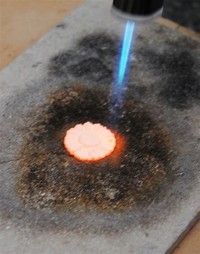Facts about Clay

Clay minerals are common in fine-grained sedimentary rocks such as shale, mudstone, and siltstone, and in fine-grained metamorphic slate and phyllite.

By using different types of clay and firing conditions, one can produce earthenware, stoneware, and porcelain.

Clays are generally formed by the chemical weathering of silicate-bearing rocks by carbonic acid, but some are formed by hydrothermal activity.

People discovered the useful properties of clay in prehistoric times, and one of the earliest artifacts ever uncovered is a drinking vessel made of sun-dried clay.

Clays have structures similar to the micas and therefore form flat, hexagonal sheets.

Clays can be categorized according to the way that the tetrahedral and octahedral sheets are packaged into "layers."

The grain size of clay is typically less than two micrometers (?m) in diameter.

Varve (or varved clay) is clay with visible annual layers, formed by seasonal differences in erosion and organic content.

Industrial processes that involve the use of clay include papermaking, cement production, pottery manufacture, and chemical filtration.

A fireplace or oven specifically designed for hardening clay is called a kiln.

Clay soils are distinguished from other types of soil such as silt by the small grain size, flake or layered shape, affinity for water, and high degree of plasticity.

Clays remain among the cheapest and most widely used materials, to make items ranging from art objects to bricks and cookware.

Clay is a term used to describe a group of fine-grained, silicate minerals known as aluminum phyllosilicates, containing variable amounts of chemically associated water.

Like all phyllosilicates, clay minerals are characterised by two-dimensional sheets of corner-sharing tetrahedra made of SiO4 and AlO4.

The properties of clay make it an ideal material for producing durable pottery items for both practical and decorative purposes.

Clay minerals are rich in silicon and aluminum oxides and hydroxides, and sometimes contain variable amounts of iron, magnesium, alkali metals, alkaline earths, and other cations.

Quick clay is a unique type of marine clay, indigenous to the glaciated terrains of Norway, Canada, and Sweden.

People discovered the useful properties of clay in prehistoric times, and one of the earliest artifacts ever uncovered is a drinking vessel made of sun-dried clay.


